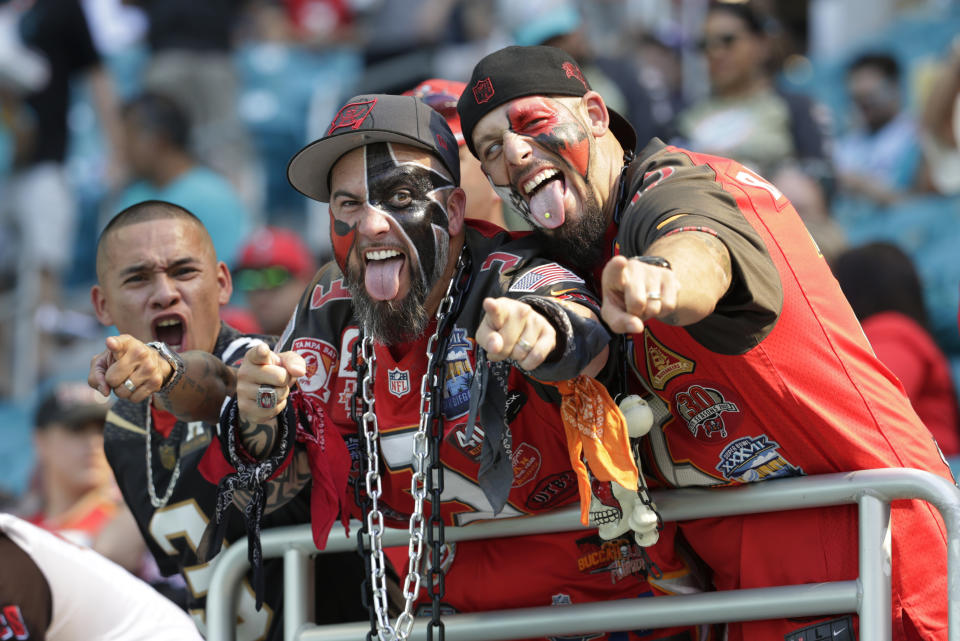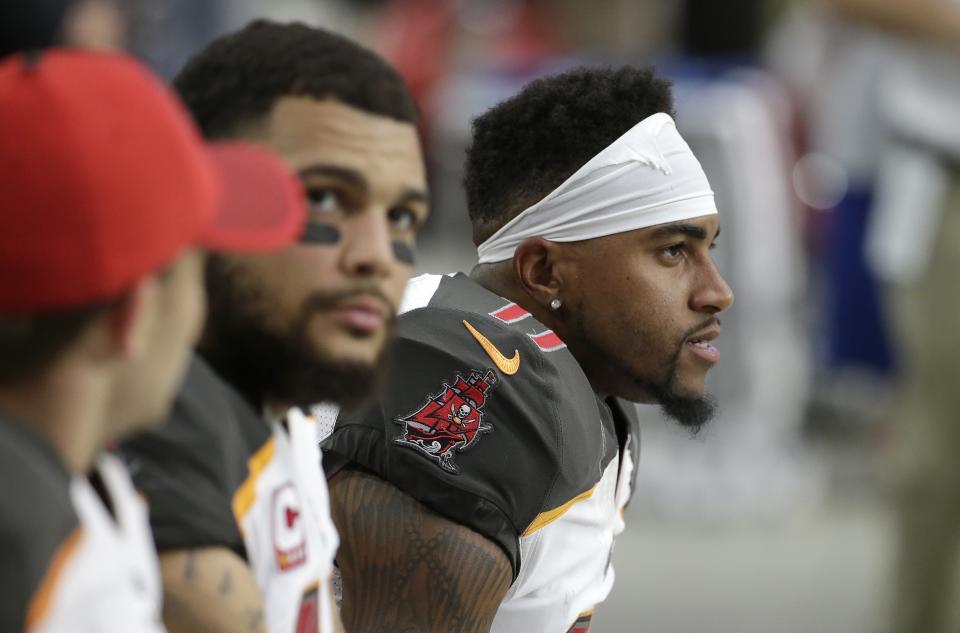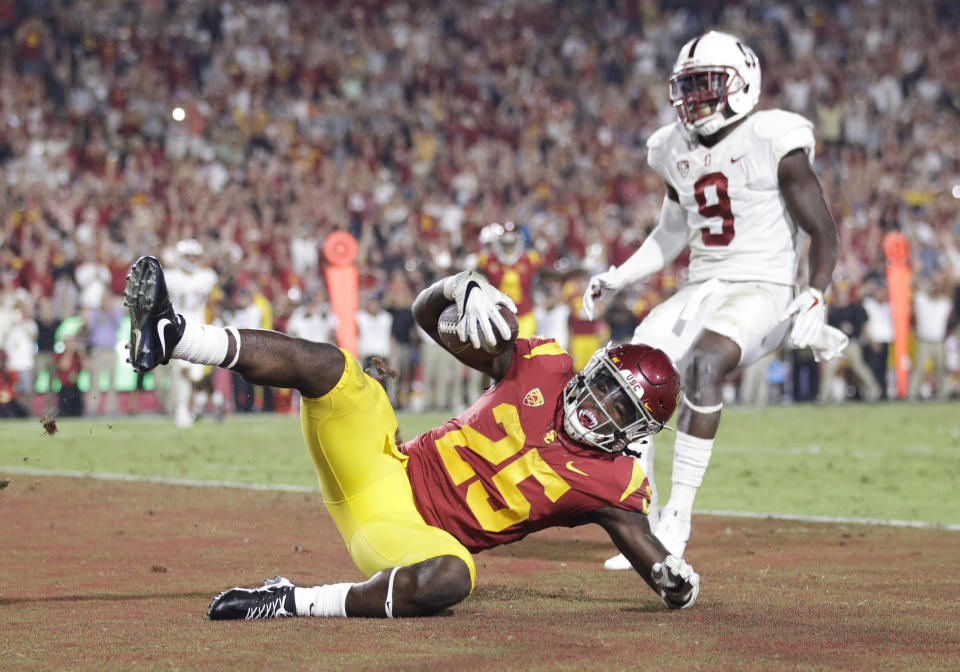Juggernaut Index, No. 20: Waiting on Jameis Winston

Tampa Bay quarterback Jameis Winston will serve a three-game suspension to open the upcoming season, a punishment related to an ugly 2016 incident. The least important aspect of a story like this is its fantasy impact, obviously, but that’s our focus around here.
Winston was a fringe QB1 before the suspension, having finished as the No. 13 scorer at his position last year. The fact that he’ll miss a quarter of the fantasy regular season should be enough to erase him from your draft plans, unless you play in a mega-league. The wait probably isn’t worth the payoff. Quarterback is a ludicrously deep position; there’s no need to seek out problems.
[Yahoo Fantasy Football leagues are open: Sign up now for free!]
Many of you do play in larger, non-standard fantasy formats, however — leagues in which 20-plus quarterbacks are going to be drafted. It’s worth noting that the Buccaneers ranked fourth in the league in passing yardage last season (272.9 YPG). If we combine Winston’s stats from 2017 with the numbers delivered by his backup Ryan Fitzpatrick (who filled in capably enough when Jameis dealt with shoulder issues), we get these totals: 4607 yards, 26 TDs, 14 INTs, 213 rush yards. That’s a useful season in our game. In fact, those stats are similar to the lines produced by top-ten fantasy QBs like Ben Roethlisberger (4251-28-14), Matthew Stafford (4446-29-10) and Philip Rivers (4515-28-10).
Winston himself produced career-bests in completion percentage (63.8), yards per attempt (7.9), interception percentage (2.5) and passer rating (92.2). He’s never been a particularly accurate QB by NFL standards, but he made clear strides last season. He’s a reasonable target for those in deeper leagues who look to go cheap at quarterback. Winston can obviously be paired with someone more reliable than Fitz, although the veteran wasn’t a problem last year (7 TDs, 3 INTs).
Tampa Bay’s receiving corps is of course led by 6-foot-5 target monster Mike Evans, one of the most reliable fantasy assets at his position. Evans received a significant payday back in March following his fourth straight 1000-yard season. His targets actually dipped a bit last year (9.0 per game vs. 10.9 in 2016), though he still finished among the league leaders. Evans’ touchdown total slipped from 12 to five, but his red-zone chances held steady (19 in 2016, 18 last year). He deserves his late second round ADP, no question.

DeSean Jackson was a notable 2017 fantasy bust
Whatever the opposite of chemistry is, that’s what Winston and DeSean Jackson had last season. Jackson caught 50 passes on 91 targets for just 668 yards, producing easily the lowest average gain of his career (13.4 Y/C). He finished with only one reception of 40 or more yards, which seems ridiculous for one of the league’s elite deep threats. Winston has publicly declared that he intends to fix the D-Jax situation…
We got this! I personally will make sure we show how valuable @DeSeanJackson11 is to our team and @NFL https://t.co/osCymbJLJu
— Jameis Winston (@Jaboowins) April 6, 2018
So that’s helpful. Maybe.
Winston actually attempted deep shots at a greater than average rate last season — 4.9 per game according to Player Profiler — which only makes Jackson’s quiet season more perplexing. This pair won’t build much rapport while Winston is suspended, so it’s tough to be optimistic about a huge rebound for D-Jax. His draft price is understandably dirt-cheap (ADP 162.2), which makes him a viable flier.
Bucs head coach Dirk Koetter suggested in postseason comments that Jackson’s issues were more about his QB:
“DeSean did his part. I see it out there in practice, I see it on the game tape. DeSean Jackson hasn’t lost a step or anything like that. Whether it was by play design or whether it was Jameis’ injury during the middle part of the season — when maybe Jameis didn’t have the confidence that he could put it on the money over 40 yards down the field. But we didn’t do a good job in that area.”
Winston didn’t encounter much trouble connecting with Chris Godwin in the receiver’s rookie season, particularly in the second-half. Godwin caught 26 passes for 442 yards on 43 targets over his final eight games, generally looking like a reliable pro. Expect his second season to look a lot like his November/December performance. Godwin has been a buzzy player throughout the spring and summer; you’ll see his name on plenty of fantasy sleeper lists before draft season is done. He was a terrific three-year collegiate player at Penn State, a receiver who can inflict damage at all levels. You don’t need to mess with him in shallow leagues, but he’s an interesting name in plus-sized fantasy formats.
Adam Humphries has produced back-to-back 600-yard seasons from the slot for the Bucs, and he remains in the team picture. Penn’s Justin Watson might have been a semi-interesting rookie on another team, but he’s buried on Tampa Bay’s receiving depth chart at the moment.
Tampa Bay offers two useful fantasy tight ends
Cameron Brate signed a huge deal this spring (six year, $41 million), roughly one year after the Bucs invested a first-round pick in O.J. Howard. Brate and Howard each delivered six TD receptions last season, finishing as the No. 8 and 16 tight ends for fantasy purposes. Howard slightly out-snapped the veteran on the year, but Brate held a decisive edge in targets (77 vs. 39) and catches (48 vs. 26). Brate’s production tailed off in in the second-half, but hip and knee injuries almost certainly played a role. It’s clear that Howard is an ascending talent, one of the best all-around young tight ends in the game, but it’s also perfectly clear that Brate will remain a fantasy relevant player. He ranked seventh at his position in red-zone targets last year (13) and he’s been a trusted option for Winston over multiple seasons.
Howard and Brate both rank just outside our consensus top-10 tight ends for fantasy purposes, as both are competing for targets in a crowded group of receivers.

Ronald Jones II, rated rookie
The Bucs released Doug Martin following two seasons of sub-3.0 YPC rushing, further marred by injuries and suspension. By December of last season, Peyton Barber had taken over as the team’s primary runner. Barber is an undrafted back entering his third year in the NFL, and he was serviceable if not spectacular in 2017. He averaged just 3.9 YPC for the season, but 4.3 in the final month as his workload increased. He’s fine — he’s not some rare talent who radiates upside, but he’s fine. With a respectable camp and preseason performance, Barber can solidify a rotational role in Tampa Bay’s backfield. But he has no realistic chance to emerge as a full-workload featured back, because his team used an early second-round pick on a terrific collegiate runner, USC’s Ronald Jones II.
Jones was an excellent back over three college seasons, gaining over 1000 scrimmage yards each year and averaging 6.1 YPC for his Trojans career. He acquitted himself well against tough opponents, on big stages, and he closed his final season with a series of big performances. Over his last six games — including a conference championship win over Stanford and bowl loss to Ohio State — he ran for 878 yards on 147 carries, finding the end-zone 11 times. Highlights piled up throughout 2017. Jones wasn’t a high-volume receiver at USC, but he had his moments on wheel routes and in the screen game. He’s a track athlete with excellent game speed, quick feet and yards-after-contact ability. Jones tweaked his hamstring at the combine, limiting his performance, but he’s now fully operational.
With an ADP that’s currently outside the overall top-50 (53.9, RB27), Jones has become one of my preferred draft targets. He’s only the sixth rookie back selected in an average fantasy draft, despite a relatively uncluttered path to 225-250 touches. He’s a steal, friends. Jones is dynamic player who was drafted to fill a major role for the Bucs. He’s drawn Jamaal Charles comps, for what it’s worth. (Charles is a very high bar. No disrespect intended to an all-time great. Both backs are 5-foot-11, both were prep stars in Texas, and both are/were electric runners.)
Tampa Bay’s defense ranked dead-last in total yards against (378.1 YPG) and passing (260.6) last season and the team’s early schedule is brutal in 2018 (at NO, vs. PHI, vs. PIT). JPP’s arrival will help, but the NFC South doesn’t offer any cupcake opponents. You want LBs Kwon Alexander and Lavonte David in IDP formats, but the Bucs’ D/ST should be left alone.
2017 Offensive Stats & Ranks
Points per game – 20.9 (18th in NFL)
Pass YPG – 272.9 (4)
Rush YPG – 90.6 (27)
Yards per play – 5.6 (9)
Plays per game – 64.7 (11)
Previous Juggernaut Index entries: 32) Buffalo, 31) Miami, 30) NY Jets, 29) Baltimore, 28) Oakland, 27) Cleveland, 26) Indianapolis, 25) Washington, 24) Chicago, 23) Tennessee, 22) Jacksonville, 21) Dallas, 20) Tampa Bay
Follow the Yahoo fantasy football crew on Twitter: Andy Behrens, Dalton Del Don, Brad Evans, Matt Harmon, Liz Loza, Scott Pianowski and Tank Williams

